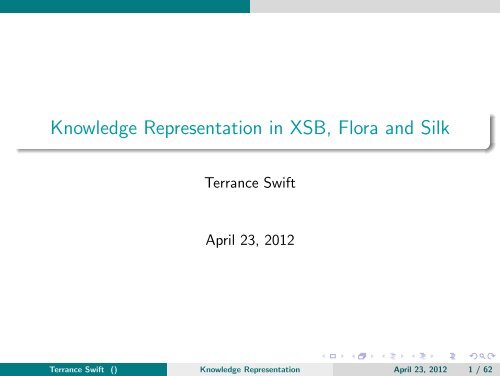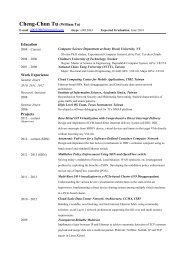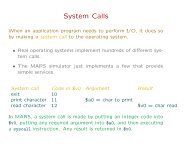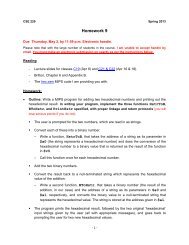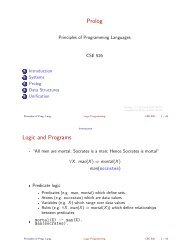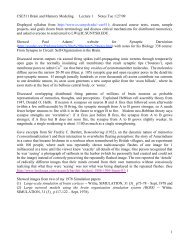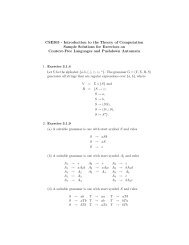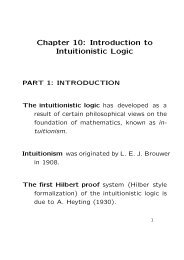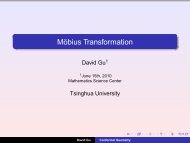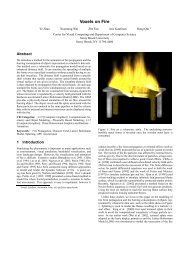Knowledge Representation in XSB, Flora and Silk - Department of ...
Knowledge Representation in XSB, Flora and Silk - Department of ...
Knowledge Representation in XSB, Flora and Silk - Department of ...
You also want an ePaper? Increase the reach of your titles
YUMPU automatically turns print PDFs into web optimized ePapers that Google loves.
<strong>Knowledge</strong> <strong>Representation</strong> <strong>in</strong> <strong>XSB</strong>, <strong>Flora</strong> <strong>and</strong> <strong>Silk</strong><br />
Terrance Swift<br />
April 23, 2012<br />
Terrance Swift () <strong>Knowledge</strong> <strong>Representation</strong> April 23, 2012 1 / 62
Part 1: Operational Semantics, Complexity <strong>and</strong><br />
Term<strong>in</strong>ation<br />
1 <strong>Knowledge</strong> <strong>Representation</strong>, Complexity <strong>and</strong> Prolog<br />
2 Tabl<strong>in</strong>g for Def<strong>in</strong>ite Programs<br />
3 Tabl<strong>in</strong>g <strong>and</strong> Negation<br />
4 Term<strong>in</strong>ation<br />
5 Defeasible Reason<strong>in</strong>g<br />
6 Summary<br />
Terrance Swift () <strong>Knowledge</strong> <strong>Representation</strong> April 23, 2012 2 / 62
<strong>Knowledge</strong> <strong>Representation</strong>, Complexity <strong>and</strong> Prolog<br />
<strong>Knowledge</strong> <strong>Representation</strong>: Provisional Def<strong>in</strong>ition<br />
<strong>Knowledge</strong> <strong>Representation</strong> <strong>and</strong> Reason<strong>in</strong>g (KRR) is an area <strong>of</strong> artificial<br />
<strong>in</strong>telligence whose fundamental goals are<br />
to be able to represent knowledge about a broad complex doma<strong>in</strong> <strong>in</strong> a<br />
manner that can be understood, created, <strong>and</strong> ma<strong>in</strong>ta<strong>in</strong>ed by<br />
non-programmers (called Subject Matter Experts (SMEs) with the<br />
collaboration <strong>of</strong> knowledge eng<strong>in</strong>eers.<br />
to be able to use this knowledge <strong>in</strong> a manner similar to that <strong>of</strong> a<br />
tra<strong>in</strong>ed expert.<br />
This is just my def<strong>in</strong>ition, but I didn’t see a better one on the web.<br />
Terrance Swift () <strong>Knowledge</strong> <strong>Representation</strong> April 23, 2012 3 / 62
<strong>Knowledge</strong> <strong>Representation</strong>, Complexity <strong>and</strong> Prolog<br />
KRR Examples<br />
One <strong>of</strong> the best-known examples is the Watson project, sponsored by<br />
IBM, which answers Jeopordy questions.<br />
Another is the Cyc system, which “... is an artificial <strong>in</strong>telligence<br />
project that attempts to assemble a comprehensive ontology <strong>and</strong><br />
knowledge base <strong>of</strong> everyday common sense knowledge”<br />
(http://en.wikipedia.org/wiki/Cyc)<br />
Whether a program to play chess would be a KRR example depends<br />
on how you <strong>in</strong>terpret the previous def<strong>in</strong>ition.<br />
Another example is the Digital Aristotle project sponsored by Vulcan,<br />
Inc (http://www.projecthalo.com), which seeks to tra<strong>in</strong> a computer<br />
to be able to use scientific knowledge at a level <strong>of</strong> US college<br />
Advanced Placement exams (similar to a baccalaureat degree).<br />
Terrance Swift () <strong>Knowledge</strong> <strong>Representation</strong> April 23, 2012 4 / 62
<strong>Knowledge</strong> <strong>Representation</strong>, Complexity <strong>and</strong> Prolog<br />
Example: U.S. College Advanced Placement Exams<br />
Regard<strong>in</strong>g mitosis <strong>and</strong> cytok<strong>in</strong>esis, one difference between higher plants<br />
<strong>and</strong> animals is that <strong>in</strong> plants<br />
(a) the sp<strong>in</strong>dles conta<strong>in</strong> cellulose micr<strong>of</strong>ibrils <strong>in</strong> addition to<br />
microtubules, whereas animal sp<strong>in</strong>dles do not conta<strong>in</strong> micr<strong>of</strong>ibrils<br />
(b) sister chromatids are identical, whereas <strong>in</strong> animals they differ from<br />
one another<br />
(c) a cell plate beg<strong>in</strong>s to form at telophase, whereas <strong>in</strong> animals a<br />
cleavage furrow is <strong>in</strong>itiated at that stage<br />
(d) chromosomes become attached to the sp<strong>in</strong>dle at prophase,<br />
whereas <strong>in</strong> animals chromosomes do not become attached until<br />
anaphase<br />
(e) sp<strong>in</strong>dle poles conta<strong>in</strong> centrioles, whereas sp<strong>in</strong>dle poles <strong>in</strong> animals<br />
do not<br />
Terrance Swift () <strong>Knowledge</strong> <strong>Representation</strong> April 23, 2012 5 / 62
<strong>Knowledge</strong> <strong>Representation</strong>, Complexity <strong>and</strong> Prolog<br />
Example: U.S. College Advanced Placement Exams<br />
Which <strong>of</strong> the follow<strong>in</strong>g <strong>of</strong>fers the best description <strong>of</strong> neural transmission<br />
across a mammalian synaptic gap?<br />
(a) Neural impulses <strong>in</strong>volve the flow <strong>of</strong> K+ <strong>and</strong> Na+ across the gap.<br />
(b) Neural impulses travel across the gap as electrical currents.<br />
(c) Neural impulses cause the release <strong>of</strong> chemicals that diffuse across<br />
the gap.<br />
(d) Neural impulses travel across the gap <strong>in</strong> both directions.<br />
(e) The calcium with<strong>in</strong> the axons <strong>and</strong> dendrites <strong>of</strong> nerves adjacent to<br />
a synapse acts as the neurotransmitter<br />
Terrance Swift () <strong>Knowledge</strong> <strong>Representation</strong> April 23, 2012 6 / 62
<strong>Knowledge</strong> <strong>Representation</strong>, Complexity <strong>and</strong> Prolog<br />
Example: U.S. College Advanced Placement Exams<br />
These are two sample questions. A KRR system should be able to<br />
answer other similar questions, that it hasn’t seen.<br />
Question answer<strong>in</strong>g is also used <strong>in</strong> the Watson KRR system.<br />
The AP task requires a KRR system that is less broad but deeper<br />
than answer<strong>in</strong>g Jeopordy questions<br />
AP answer<strong>in</strong>g for biology requires representation <strong>and</strong> reason<strong>in</strong>g about<br />
processes, temporal events, <strong>and</strong> spatial relations, <strong>in</strong> addition to general<br />
logical <strong>and</strong> ontological reason<strong>in</strong>g.<br />
As with Jeopordy the AP doma<strong>in</strong> requires<br />
Weigh<strong>in</strong>g alternatives about the “best” answer (though neither requires<br />
explicitly probabilistic reason<strong>in</strong>g).<br />
A natural language <strong>in</strong>terface<br />
Both <strong>of</strong> these systems employ reason<strong>in</strong>g that has low computational<br />
complexity, rather than highly expressive theorem prov<strong>in</strong>g systems.<br />
Terrance Swift () <strong>Knowledge</strong> <strong>Representation</strong> April 23, 2012 7 / 62
<strong>Knowledge</strong> <strong>Representation</strong>, Complexity <strong>and</strong> Prolog<br />
Low-Complexity <strong>Knowledge</strong> <strong>Representation</strong><br />
A very small fragment from a large rule set to support process reason<strong>in</strong>g<br />
(<strong>Flora</strong>-2 syntax).<br />
// a transitive relation from a given 1st to a 3rd holds<br />
// if it holds from the 1st to the 2nd <strong>and</strong> from 2nd to the 3rd.<br />
?r(?a, ?c) :- allow(transitive) <strong>and</strong> transitive(?r)<br />
<strong>and</strong> %silkb#isGround(?a)@built<strong>in</strong> <strong>and</strong> %silkb#isGround(?b)@built<strong>in</strong><br />
<strong>and</strong> ?a != ?c <strong>and</strong> ?r(?a, ?b) <strong>and</strong> ?r(?b, ?c) .<br />
// a transitive relation from a given 1st to a 3rd holds<br />
// if it holds from the 1st to the 2nd <strong>and</strong> from 2nd to the 3rd.<br />
?r(?a, ?c) :- allow(transitive) <strong>and</strong> transitive(?r)<br />
<strong>and</strong> %silkb#isGround(?a)@built<strong>in</strong> <strong>and</strong> not %silkb#isGround(?b)@built<strong>in</strong><br />
<strong>and</strong> ?r(?a, ?b) <strong>and</strong> ?r(?b, ?c) <strong>and</strong> ?a != ?c .<br />
// a transitive relation from a 1st to a given 3rd holds<br />
// if it holds from a 2nd to the 3rd <strong>and</strong> from the the 1st to the 2nd’’] .<br />
?r(?a, ?c) :- allow(transitive) <strong>and</strong> transitive(?r)<br />
<strong>and</strong> not %silkb#isGround(?a)@built<strong>in</strong> <strong>and</strong> %silkb#isGround(?c)@built<strong>in</strong><br />
<strong>and</strong> ?r(?b, ?c) <strong>and</strong> ?r(?a, ?b) <strong>and</strong> ?a != ?c .<br />
Terrance Swift () <strong>Knowledge</strong> <strong>Representation</strong> April 23, 2012 8 / 62
<strong>Knowledge</strong> <strong>Representation</strong>, Complexity <strong>and</strong> Prolog<br />
Some Biology Axioms that use the Process Ontology<br />
cyc:SitTypeFollowsSitTypeInSitType(cellCycle,mitosis,<strong>in</strong>terphase)<br />
after(ends,beg<strong>in</strong>s)(<strong>in</strong>(cell(cycle))(mitosis,<strong>in</strong>terphase)<br />
immediate(part(<strong>of</strong>))(mitosis,phase(M))<br />
exclusively(part(<strong>of</strong>))(phase(M),cell(cycle));<br />
Terrance Swift () <strong>Knowledge</strong> <strong>Representation</strong> April 23, 2012 9 / 62
<strong>Knowledge</strong> <strong>Representation</strong>, Complexity <strong>and</strong> Prolog<br />
Low-Complexity <strong>Knowledge</strong> <strong>Representation</strong><br />
Many KRR systems are quite declarative but have high computational<br />
complexity<br />
First-order logic is undecidable<br />
Description logics are tractable subsets <strong>of</strong> first-order logic.<br />
Description logics based on ALC or its extension are<br />
PSPACE-complete, or det-EXPTIME-complete (e.g. ALCQ).<br />
Answer-set programm<strong>in</strong>g is NP-complete (credulous, a query is true <strong>in</strong><br />
a model), or co-NP complete (skeptical – a query is true <strong>in</strong> all models)<br />
Well-founded semantics is O(size(P) × atoms(P)) for a ground<br />
program P. In practice, usually it acts as O(size(P).<br />
Terrance Swift () <strong>Knowledge</strong> <strong>Representation</strong> April 23, 2012 10 / 62
<strong>Knowledge</strong> <strong>Representation</strong>, Complexity <strong>and</strong> Prolog<br />
Low-Complexity <strong>Knowledge</strong> <strong>Representation</strong><br />
High-complexity approaches <strong>of</strong>ten are not suitable for large-scale<br />
applications, e.g., semantic web, enterprise KR.<br />
So, rather than start<strong>in</strong>g with high-complexity approaches, we start<br />
with a low complexity approach (WFS) <strong>and</strong> extend it. Extensions<br />
<strong>in</strong>clude:<br />
CLP(R), CLP(Q), CLP(FD).<br />
Low-complexity description logics: EL + [BBL05], Description Logic<br />
Programs [GHVD03]<br />
Probability <strong>in</strong>ference (to be discussed <strong>in</strong> another lecture)<br />
Terrance Swift () <strong>Knowledge</strong> <strong>Representation</strong> April 23, 2012 11 / 62
<strong>Knowledge</strong> <strong>Representation</strong>, Complexity <strong>and</strong> Prolog<br />
Prolog as a KRR tool<br />
“What more do you need?”<br />
Horn clauses have both a procedural <strong>and</strong> a logical semantics<br />
Allow easy creation <strong>of</strong> recursive types<br />
Efficient, robust, <strong>and</strong> scalable implementation<br />
Dynamic code allows changeable or self-modify<strong>in</strong>g code.<br />
Constra<strong>in</strong>ts allow numeric or comb<strong>in</strong>atorial reason<strong>in</strong>g<br />
Terrance Swift () <strong>Knowledge</strong> <strong>Representation</strong> April 23, 2012 12 / 62
<strong>Knowledge</strong> <strong>Representation</strong>, Complexity <strong>and</strong> Prolog<br />
Prolog as a KRR tool<br />
“Are you crazy?”<br />
Negation <strong>in</strong> Prolog is <strong>of</strong>ten useful but has a weak semantics<br />
Completion semantics cannot be extended to allow positive recursion<br />
The Fitt<strong>in</strong>g fixed po<strong>in</strong>t semantics [Fit85] is still weak (it keeps the<br />
truth value <strong>of</strong> many atoms as undef<strong>in</strong>ed).)<br />
Prolog doesn’t term<strong>in</strong>ate when it should, <strong>and</strong> programs can suffer<br />
from poor complexity.<br />
Prolog isn’t “smart” about its search unlike e.g., Cyc<br />
Programm<strong>in</strong>g with constra<strong>in</strong>ts is powerful, but can be difficult.<br />
Terrance Swift () <strong>Knowledge</strong> <strong>Representation</strong> April 23, 2012 13 / 62
<strong>Knowledge</strong> <strong>Representation</strong>, Complexity <strong>and</strong> Prolog<br />
Tabl<strong>in</strong>g as a KRR tool<br />
Claim: Tabl<strong>in</strong>g fundamentally changes Prolog so that it is suitable as a<br />
KRR tool<br />
You should be skeptical <strong>of</strong> this claim until it is substantiated.<br />
Tabl<strong>in</strong>g supports the Well-founded Semantics (WFS) which can be<br />
used as a basis <strong>of</strong> defeasible reason<strong>in</strong>g<br />
Tabl<strong>in</strong>g with answer subsumption forms a basis for quantitative <strong>and</strong><br />
multi-valued logics<br />
Tabl<strong>in</strong>g with call abstraction can give powerful term<strong>in</strong>ation properties<br />
Tabl<strong>in</strong>g works well with dynamic code <strong>and</strong> tables can be <strong>in</strong>crementally<br />
updated<br />
Tabl<strong>in</strong>g extends rather than replaces Prolog semantics, <strong>in</strong>clud<strong>in</strong>g<br />
constra<strong>in</strong>ts<br />
These computational techniques support new KRR languages such as<br />
<strong>Flora</strong>-2, <strong>Silk</strong>, <strong>and</strong> PITA.<br />
Terrance Swift () <strong>Knowledge</strong> <strong>Representation</strong> April 23, 2012 14 / 62
Tabl<strong>in</strong>g for Def<strong>in</strong>ite Programs<br />
An Example <strong>of</strong> SLD Evaluation<br />
reach (1,X),edge(X,Z),edge(Z,Z1),edge(Z1,Y)<br />
edge1,2).<br />
reach(1,X),edge(X,Y)<br />
reach(X,Y):− reach(X,Z),reach(Z,Y).<br />
reach(X,Y):− reach(X,Y).<br />
edge(2,3).<br />
reach(1,Y)<br />
reach(1,X),edge(X,Z),edge(X,Y) edge(1,X),edge(X,Y)<br />
edge(2,Y)<br />
Y = 3<br />
edge(1,Y)<br />
Terrance Swift () <strong>Knowledge</strong> <strong>Representation</strong> April 23, 2012 15 / 62<br />
Y = 2
Tabl<strong>in</strong>g for Def<strong>in</strong>ite Programs<br />
An Example <strong>of</strong> SLD Evaluation<br />
The previous slide highlights some problems with SLD evaluation<br />
The SLD tree conta<strong>in</strong>s all solutions (completeness) but is <strong>in</strong>f<strong>in</strong>ite<br />
(non-term<strong>in</strong>ation)<br />
If you simply check for loops, you can achieve term<strong>in</strong>ation, but you<br />
don’t address complexity, which is also a problem with SLD.<br />
Terrance Swift () <strong>Knowledge</strong> <strong>Representation</strong> April 23, 2012 16 / 62
Tabl<strong>in</strong>g for Def<strong>in</strong>ite Programs<br />
An Example <strong>of</strong> SLG (Tabled) Evaluation<br />
4. reach(1,Y):− edge(2,Y) 6. reach(1,Y):− edge(3,Y) 3. reach(1,2):−<br />
5. reach(1,3):−<br />
0. reach(1,Y):− reach(1,Y)<br />
1. reach(1,Y):− reach(1,X),edge(X,Y) 2. reach(1,Y):− edge(1,Y)<br />
Terrance Swift () <strong>Knowledge</strong> <strong>Representation</strong> April 23, 2012 17 / 62
Tabl<strong>in</strong>g for Def<strong>in</strong>ite Programs<br />
Def<strong>in</strong>ite Programs: SLD vs. Tabl<strong>in</strong>g<br />
Tabl<strong>in</strong>g factors out redundant subcomputations (here r(1,Y)) to<br />
compute the m<strong>in</strong>imal model <strong>of</strong> a def<strong>in</strong>ite program (expressible as the<br />
least fixed po<strong>in</strong>t <strong>of</strong> the TP monotonic operator).<br />
Nodes have the form fail or<br />
AnswerTemplate :- Delays|GoalList<br />
Delays is only needed for negation, so we’ll ignore that for now<br />
If a tree T has root A :- |A, then A is termed the root subgoal <strong>of</strong> T .<br />
In this formulation, answers are (non-failure) leaf nodes whose goal<br />
list is empty.<br />
Examples <strong>in</strong> these slides use Prolog’s top to bottom clause selection<br />
strategy <strong>and</strong> left-to-right literal selection strategy. These order<strong>in</strong>gs are<br />
among many that are possible.<br />
Terrance Swift () <strong>Knowledge</strong> <strong>Representation</strong> April 23, 2012 18 / 62
Tabl<strong>in</strong>g for Def<strong>in</strong>ite Programs<br />
Def<strong>in</strong>ite Programs: Tabl<strong>in</strong>g Operations<br />
From [Swi99], based on [CW96].<br />
1 New Subgoal: Let Fn be a forest that conta<strong>in</strong>s a non-root node<br />
N = D|Ans :- G, Goal List<br />
where G is the selected literal S or not S. Assume Fn conta<strong>in</strong>s no tree with<br />
root subgoal S. Then add the tree S :- |S to Fn.<br />
2 Program Clause Resolution: Let Fn conta<strong>in</strong> a root node N = S :- |S<br />
<strong>and</strong> C be a program clause Head :- Body such that Head unifies with S<br />
with mgu θ. Assume that <strong>in</strong> Fn, N does not have a child<br />
Nchild = (S :- |Body)θ. Then add Nchild as a child <strong>of</strong> N.<br />
3 Positive Return: Let Fn conta<strong>in</strong> a non-root node N whose selected<br />
literal S is positive. Let Ans be an answer node for S <strong>in</strong> Fn <strong>and</strong> Nchild be<br />
the SLG resolvent <strong>of</strong> N <strong>and</strong> Ans on S. Assume that <strong>in</strong> Fn, N does not have<br />
a child Nchild. Then add Nchild as a child <strong>of</strong> N 1 .<br />
4 Completion: Given a completely evaluated set S <strong>of</strong> subgoals where the<br />
tree for no subgoal S ∈ S is marked completed, mark the trees for all<br />
subgoals <strong>in</strong> S as completed.<br />
1 For def<strong>in</strong>ite programs, simple resolution is all that is needed.<br />
Terrance Swift () <strong>Knowledge</strong> <strong>Representation</strong> April 23, 2012 19 / 62
Tabl<strong>in</strong>g for Def<strong>in</strong>ite Programs<br />
Def<strong>in</strong>ite Programs: Completion<br />
What does Completely Evaluated mean?<br />
A subgoal is completely evaluated iff it has all <strong>of</strong> its possible answers.<br />
A subgoal S is completely evaluated when all possible operations have<br />
been done on its nodes, <strong>and</strong> the nodes <strong>of</strong> trees upon which S depends.<br />
A ground subgoal is completely evaluated when an answer is derived for<br />
it.<br />
Incremental Completion is necessary for efficient evaluation <strong>of</strong><br />
programs.<br />
We also haven’t yet def<strong>in</strong>ed | or SLG answer resolution – these will be<br />
def<strong>in</strong>ed when we <strong>in</strong>troduce non-stratified negation<br />
For now, ignore | <strong>and</strong> th<strong>in</strong>k <strong>of</strong> SLG answer resolution as the resolution<br />
<strong>of</strong> a fact aga<strong>in</strong>st the leftmost argument <strong>of</strong> a goal.<br />
Terrance Swift () <strong>Knowledge</strong> <strong>Representation</strong> April 23, 2012 20 / 62
Tabl<strong>in</strong>g for Def<strong>in</strong>ite Programs<br />
Def<strong>in</strong>ite Programs: Completion<br />
But what does depends mean, exactly?<br />
Def<strong>in</strong>ition (Subgoal Dependency Graph)<br />
Let F be a forest <strong>in</strong> a SLG evaluation. A tabled subgoal S1 directly depends on a<br />
tabled subgoal S2 <strong>in</strong> F iff neither the tree for S1 nor that for S2 is marked as<br />
complete <strong>and</strong> S2 is the selected literal <strong>of</strong> some node <strong>in</strong> the tree for S1.<br />
The Subgoal Dependency Graph <strong>of</strong> F, SDG(F), is a directed graph V,E <strong>in</strong> which<br />
V is the set <strong>of</strong> root goals for non-completed trees <strong>in</strong> F <strong>and</strong> (Si, Sj) ∈ E iff Si<br />
directly depends on Sj.<br />
Terrance Swift () <strong>Knowledge</strong> <strong>Representation</strong> April 23, 2012 21 / 62
Tabl<strong>in</strong>g for Def<strong>in</strong>ite Programs<br />
Def<strong>in</strong>ite Programs: Example<br />
1. p(1,Y)
Tabl<strong>in</strong>g for Def<strong>in</strong>ite Programs<br />
Def<strong>in</strong>ite Programs: An SDG<br />
p(1.Z)<br />
p(2,Z)<br />
p(3,Z)<br />
Terrance Swift () <strong>Knowledge</strong> <strong>Representation</strong> April 23, 2012 23 / 62
Tabl<strong>in</strong>g for Def<strong>in</strong>ite Programs<br />
Tabl<strong>in</strong>g for Def<strong>in</strong>ite Programs: Summary<br />
Let’s assume we have an atomic query Q. We start with a forest<br />
consist<strong>in</strong>g <strong>of</strong> the s<strong>in</strong>gle tree Q :- |Q. From then on we apply<br />
applicable SLG operations until no more operations apply. This is an<br />
SLG evaluation.<br />
Theoretically, SLG evaluations may have an <strong>in</strong>f<strong>in</strong>ite number <strong>of</strong> steps.<br />
But we won’t worry here about which <strong>in</strong>f<strong>in</strong>ite ord<strong>in</strong>al an evaluation<br />
stops at: term<strong>in</strong>ation means f<strong>in</strong>ite term<strong>in</strong>ation <strong>in</strong> these slides.<br />
The order<strong>in</strong>g <strong>of</strong> applicable operations is called a schedul<strong>in</strong>g strategy<br />
<strong>XSB</strong> mostly uses local schedul<strong>in</strong>g (cf. [MS08]) which is illustrated by<br />
the forest on Slide 22. That’s what we use here.<br />
The def<strong>in</strong>ition follows, but you can th<strong>in</strong>k <strong>of</strong> local evaluation as<br />
depth-first search for tabl<strong>in</strong>g. The evaluation explores SCCs <strong>in</strong> the<br />
search space <strong>in</strong> a depth-first manner.<br />
Terrance Swift () <strong>Knowledge</strong> <strong>Representation</strong> April 23, 2012 24 / 62
Tabl<strong>in</strong>g for Def<strong>in</strong>ite Programs<br />
Def<strong>in</strong>ite Programs: Local Evaluation<br />
How should the operations New Answer, Program Clause Resolution,<br />
Positive Return, <strong>and</strong> Completion – be scheduled?<br />
Completion should be performed <strong>in</strong>crementally to save space.<br />
Program Clause Resolution should be scheduled as <strong>in</strong> Prolog, as far as<br />
possible.<br />
New Subgoal should be performed as soon as a goal is encountered, to accord<br />
with Prolog’s search strategy<br />
This leaves the question <strong>of</strong> how to schedule Positive Return w.r.t Program<br />
Clause Resolution<br />
Def<strong>in</strong>ition (Locality property)<br />
Let F be an SLG forest. Resolution <strong>of</strong> an answer A aga<strong>in</strong>st a consum<strong>in</strong>g node N occurs<br />
<strong>in</strong> an <strong>in</strong>dependent SCC <strong>of</strong> F if the root subgoal for N is <strong>in</strong> an <strong>in</strong>dependent SCC <strong>in</strong><br />
SDG(F). An SLG evaluation has the locality property if any answer resolution<br />
operation applied to a state Fn occurs <strong>in</strong> an <strong>in</strong>dependent SCC <strong>of</strong> Fn.<br />
Terrance Swift () <strong>Knowledge</strong> <strong>Representation</strong> April 23, 2012 25 / 62
Tabl<strong>in</strong>g for Def<strong>in</strong>ite Programs<br />
Term<strong>in</strong>ation for Def<strong>in</strong>ite Datalog Programs<br />
Let’s consider a special case <strong>of</strong> (f<strong>in</strong>ite!) term<strong>in</strong>ation: that <strong>of</strong> def<strong>in</strong>ite datalog<br />
programs (i.e. def<strong>in</strong>ite programs that don’t conta<strong>in</strong> any function symbols).<br />
Recall that the Herbr<strong>and</strong> Base for datalog programs is f<strong>in</strong>ite.<br />
Let P be a (f<strong>in</strong>ite) datalog program <strong>in</strong> which every predicate is tabled. We<br />
want to show that any query Q to P term<strong>in</strong>ates. We can show this by<br />
show<strong>in</strong>g that any SLG evaluation is f<strong>in</strong>ite.<br />
Consider the New Subgoal operation. The def<strong>in</strong>ition stated: Assume Fn<br />
conta<strong>in</strong>s no tree with root subgoal S. We assume that any two subgoals<br />
(atoms) that are variants are identical. S<strong>in</strong>ce the Herbr<strong>and</strong> Base is f<strong>in</strong>ite,<br />
there can only be a f<strong>in</strong>ite number <strong>of</strong> New Subgoal operations <strong>in</strong> the<br />
evaluation (<strong>and</strong> the f<strong>in</strong>al forest <strong>of</strong> the evaluation has only a f<strong>in</strong>ite number <strong>of</strong><br />
trees).<br />
Similarly, the Program Clause Resolution def<strong>in</strong>ition stated: Assume<br />
that <strong>in</strong> Fn, N does not have a child Nchild = (S :- |Body)θ. So any clause<br />
S ′ :- Body where S ′ unifies with S can only be resolved once, <strong>and</strong> there can<br />
only be a f<strong>in</strong>ite number <strong>of</strong> Program Clause Resolution operations.<br />
Terrance Swift () <strong>Knowledge</strong> <strong>Representation</strong> April 23, 2012 26 / 62
Tabl<strong>in</strong>g for Def<strong>in</strong>ite Programs<br />
Term<strong>in</strong>ation for Def<strong>in</strong>ite Datalog Programs<br />
For the case <strong>of</strong> Positive Return, s<strong>in</strong>ce the Herbr<strong>and</strong> Base is f<strong>in</strong>ite, there<br />
can only be a f<strong>in</strong>ite number <strong>of</strong> answers. The def<strong>in</strong>ition prevents the same<br />
answer be<strong>in</strong>g used for resolution aga<strong>in</strong>st the same node more than once via<br />
the statement: Assume that <strong>in</strong> Fn, N does not have a child<br />
Nchild = (S :- |Body)θ.<br />
The def<strong>in</strong>ition <strong>of</strong> completion explicitly prevents a tree from be<strong>in</strong>g marked<br />
as complete more than once. S<strong>in</strong>ce there are a f<strong>in</strong>ite number <strong>of</strong> trees, there<br />
can only be a f<strong>in</strong>ite number <strong>of</strong> completion operations.<br />
S<strong>in</strong>ce there can only be a f<strong>in</strong>ite number <strong>of</strong> each k<strong>in</strong>d <strong>of</strong> operation the SLG<br />
evaluation is f<strong>in</strong>ite. Also, note that each tree will only have a f<strong>in</strong>ite number<br />
<strong>of</strong> nodes <strong>in</strong> it: we have a f<strong>in</strong>ite forest <strong>of</strong> f<strong>in</strong>ite trees.<br />
Assum<strong>in</strong>g ideal <strong>in</strong>dex<strong>in</strong>g, all operations except completion can be made <strong>in</strong><br />
constant time. [SS98] provides an algorithm for perform<strong>in</strong>g <strong>in</strong>cremental<br />
completion so that the sum <strong>of</strong> all completion operations is O(size(P)).<br />
Terrance Swift () <strong>Knowledge</strong> <strong>Representation</strong> April 23, 2012 27 / 62
Tabl<strong>in</strong>g <strong>and</strong> Negation<br />
Tabl<strong>in</strong>g <strong>and</strong> Negation<br />
A loop through negation occurs when a subgoal S calls a series <strong>of</strong> subgoals that<br />
end up call<strong>in</strong>g tnot(S). We’ll treat this <strong>in</strong>formally, but programs that conta<strong>in</strong> no<br />
“loops through negation” can be formalized as fixed-order stratified<br />
programs [SSW00]<br />
For programs that conta<strong>in</strong> no loops through negation, we add the operation<br />
Negative Return Let Fn conta<strong>in</strong> a leaf node<br />
N = Ans :- not S, Goal List.<br />
whose selected literal not S is ground.<br />
1 Negative Success: If S is failed <strong>in</strong> F <strong>and</strong> N has no children, create a<br />
child for N <strong>of</strong> the form: Ans :- Goal List.<br />
2 Negative Failure: If S successful <strong>in</strong> F <strong>and</strong> N has no children, create a<br />
child for N <strong>of</strong> the form fail 2<br />
However, we will see that well-founded programs can conta<strong>in</strong> loops through<br />
negation that become resolved.<br />
2 The terms successful <strong>and</strong> failed will be def<strong>in</strong>ed later.<br />
Terrance Swift () <strong>Knowledge</strong> <strong>Representation</strong> April 23, 2012 28 / 62
Negation: Example<br />
Tabl<strong>in</strong>g <strong>and</strong> Negation<br />
p(b).<br />
p(c) :- not p(a).<br />
p(X) :- t(X,Y,Z), not p(Y), not p(Z).<br />
t(a,b,a). t(a,a,b).<br />
The ground <strong>in</strong>stantiation <strong>of</strong> the above program is:<br />
p(b).<br />
p(c):- not p(a).<br />
p(a) :- t(a,a,a), not p(a), not p(a).<br />
p(a) :- t(a,a,b), not p(a), not p(b).<br />
:<br />
p(a) :- t(a,b,a), not p(b), not p(a).<br />
v:<br />
p(c) :- t(c,c,c), not p(c), not p(c).<br />
t(a,b,a). t(a,a,b).<br />
This program has a 2-valued model: w.r.t p/1 it is<br />
{p(b), p(c)} = true; {p(a)} = false<br />
but it cannot be evaluated with a fixed literal selection strategy<br />
Terrance Swift () <strong>Knowledge</strong> <strong>Representation</strong> April 23, 2012 29 / 62
Tabl<strong>in</strong>g <strong>and</strong> Negation<br />
Negation: Tabled Evaluation <strong>of</strong> WFS<br />
The method just shown was pure bottom-up.<br />
To make it goal-oriented requires a notion <strong>of</strong> relevance.<br />
Assum<strong>in</strong>g (as always) a left-to-right computation rule:<br />
In Prolog, relevant literals for a selected clause belong to a fail<strong>in</strong>g<br />
prefix.<br />
p(a) :- t(a,b,a), not p(b), not p(a).<br />
To get this dynamic stratification an evaluation cannot view only a<br />
prefix.<br />
p(a) :- t(a,a,b), not p(a), not p(b).<br />
Are relevant literals all those <strong>in</strong> a body for a selected clause?<br />
Terrance Swift () <strong>Knowledge</strong> <strong>Representation</strong> April 23, 2012 30 / 62
4. p(a):−<br />
| t(a,a,b),not p(a), not p(b).<br />
5. p(a):− | not p(a),not p(b)<br />
Tabl<strong>in</strong>g <strong>and</strong> Negation<br />
1. p(c):− | p(c)<br />
2. p(c):− | not p(a)<br />
3. p(a):− | p(a)<br />
8. p(b) :− | p(b)<br />
9. p(b) :− |<br />
6. p(a):− | t(a,b,a),not p(b), not p(a).<br />
7. p(b):− | not p(b), not p(a)<br />
(completed)<br />
10, fail<br />
:- table p/1.<br />
p(b). p(c) :- not p(a).<br />
p(X) :- t(X,Y,Z), not p(Y), not p(Z).<br />
t(a,b,a). t(a,a,b).<br />
Terrance Swift () <strong>Knowledge</strong> <strong>Representation</strong> April 23, 2012 31 / 62
4. p(a):− |<br />
t(a,a,b),not p(a), not p(b).<br />
5. p(a):− | not p(a),not p(b)<br />
12. p(a):− not p(a) | not p(b)<br />
13. fail<br />
Tabl<strong>in</strong>g <strong>and</strong> Negation<br />
1. p(c):− | p(c)<br />
2. p(c):− | not p(a)<br />
11. p(c):− not p(a) |<br />
3. p(a):− | p(a)<br />
8. p(b):− |p(b)<br />
9. p(b) :− |<br />
6. p(a):− | t(a,b,a),not p(b), not p(a).<br />
7. p(b):− | not p(b), not p(a)<br />
completed<br />
10. fail<br />
:- table p/1.<br />
p(b). p(c) :- not p(a).<br />
p(X) :- t(X,Y,Z), not p(Y), not p(Z).<br />
t(a,b,a). t(a,a,b).<br />
Terrance Swift () <strong>Knowledge</strong> <strong>Representation</strong> April 23, 2012 32 / 62
5 p(a):− |tnot p(a),tnot p(b)<br />
13 p(a):− tnot p(a) | tnot p(b)<br />
14 fail<br />
Tabl<strong>in</strong>g <strong>and</strong> Negation<br />
1 p(c) :− | p(c)<br />
2 p(c):− | tnot p(a)<br />
12 p(c):− tnot p(a) |<br />
17 p(c) :− |<br />
3 p(a) :− | p(a)<br />
4 p(a):− |t(a,Y,Z),tnot p(Y), tnot p(Z).<br />
6 p(a):− | tnot p(b), tnot p(a) 10 p(a):− | tnot p(c), tnot p(b).<br />
11 fail<br />
7 p(b) :− | p(b)<br />
8 p(b) :− |<br />
15 p(a):− tnot p(c) | tnot p(b).<br />
9a complete<br />
16 fail<br />
9 p(b):− |t(b,Y,Z),tnot p(Y), tnot p(Z).<br />
:- table p/1.<br />
p(b). p(c) :- not p(a).<br />
p(X) :- t(X,Y,Z), not p(Y), not p(Z).<br />
t(a,b,a). t(a,a,b).<br />
Terrance Swift () <strong>Knowledge</strong> <strong>Representation</strong> April 23, 2012 33 / 62
Tabl<strong>in</strong>g <strong>and</strong> Negation<br />
Negation: Tabled Evaluation <strong>of</strong> WFS<br />
Let’s review how each node was produced.<br />
1 Initial Forest<br />
2 Program Clause Resolution<br />
3 New Subgoal<br />
4 Program Clause Resolution<br />
5 Program Clause Resolution (t/3 is not tabled)<br />
6 Program Clause Resolution<br />
7 Program Clause Resolution<br />
8 New Subgoal<br />
9 Program Clause Resolution<br />
10 Completion <strong>of</strong> p(b) + Negative Return<br />
11 Delay<strong>in</strong>g<br />
12 Delay<strong>in</strong>g<br />
13 Negative Return<br />
14 Simplification<br />
Note that the evaluation was not delay-m<strong>in</strong>imal, <strong>and</strong> completion was not fully <strong>in</strong>cremental. If<br />
the delay<strong>in</strong>g operation <strong>in</strong> 12 had been performed <strong>and</strong> p(a) completed, no Delay<strong>in</strong>g operation<br />
would have been needed <strong>in</strong> the p(c) tree.<br />
Also note that we can mix evaluation <strong>of</strong> tabled with non-tabled predicates.<br />
Terrance Swift () <strong>Knowledge</strong> <strong>Representation</strong> April 23, 2012 34 / 62
Tabl<strong>in</strong>g <strong>and</strong> Negation<br />
Negation: Tabled Evaluation <strong>of</strong> WFS<br />
So that’s what the | means.<br />
An answer is unconditional if there are no literals to the left <strong>of</strong> the |; otherwise it is<br />
conditional<br />
Let F be a forest. We say that an atom S is failed <strong>in</strong> F if S is completely<br />
evaluated <strong>in</strong> F, <strong>and</strong> S has no answers. We say that an atom S is successful <strong>in</strong> F if<br />
the tree for S has an unconditional answer S.<br />
SLG Answer Resolution Let N be a node H :- D|L1, ..., Ln, where n > 0. Let<br />
Ans = A ′ :- D ′ | be an answer whose variables have been st<strong>and</strong>ardized apart from<br />
N. N is SLG resolvable with Ans if Li <strong>and</strong> A ′ are unifiable with an mgu θ. The<br />
SLG resolvent <strong>of</strong> N <strong>and</strong> Ans on Li has the form<br />
if D ′ is empty, <strong>and</strong><br />
(A :- D|L1, ..., Li−1, Li+1, ..., Ln)θ<br />
(A :- D, D|L1, ..., Li−1, Li+1, ..., Ln)θ<br />
otherwise, where D = Li if Li is negative, <strong>and</strong> D = Li L i<br />
A ′ otherwise.<br />
Positive delayed literals are added only by SLG Answer Resolution, not<br />
directly by Delay<strong>in</strong>g<br />
Terrance Swift () <strong>Knowledge</strong> <strong>Representation</strong> April 23, 2012 35 / 62
Tabl<strong>in</strong>g <strong>and</strong> Negation<br />
Negation: Tabled Evaluation <strong>of</strong> WFS<br />
We <strong>in</strong>troduced two new operations which may be applicable to a node <strong>in</strong> a<br />
forest Fn:<br />
Delay<strong>in</strong>g: 3 Let Fn conta<strong>in</strong> a leaf node<br />
N = Ans :- DelaySet|not S, Goal List<br />
with selected literal not S such that S is ground, <strong>in</strong> Fn, but S is<br />
neither successful nor failed <strong>in</strong> Fn. Then create a child for N <strong>of</strong> the<br />
form<br />
Ans :- {DelaySet ∪ not S}|Goal List<br />
if N does not already have such a child.<br />
3 This def<strong>in</strong>ition <strong>of</strong> Delay<strong>in</strong>g assumes a left-to-right literal selection strategy.<br />
Terrance Swift () <strong>Knowledge</strong> <strong>Representation</strong> April 23, 2012 36 / 62
Tabl<strong>in</strong>g <strong>and</strong> Negation<br />
Negation: Tabled Evaluation <strong>of</strong> WFS<br />
Simplification: Let Fn conta<strong>in</strong> a leaf node N = Ans :- DelaySet| with<br />
D ∈ Delayset.<br />
If D = not Subg <strong>and</strong><br />
Subg is failed <strong>in</strong> Fn then create a child Ans :- DelaySet ′ | for N, where<br />
Delay Set ′ = Delay Set − Subg, if N does not already have such a<br />
child.<br />
Subg succeeds <strong>in</strong> Fn then create a child fail for N, if N does not<br />
already have such a child.<br />
Otherwise, if D = L Subg<br />
A ′<br />
<strong>and</strong><br />
A ′ succeeds <strong>in</strong> Fn, then create a child Ans :- DelaySet ′ | for N, where<br />
Delay Set ′ = Delay Set − Subg, if N does not already have such a<br />
child.<br />
A ′ is failed <strong>in</strong> Fn, then create a child fail for N, if N does not already<br />
have such a child.<br />
Terrance Swift () <strong>Knowledge</strong> <strong>Representation</strong> April 23, 2012 37 / 62
Tabl<strong>in</strong>g <strong>and</strong> Negation<br />
Negation: Tabled Evaluation <strong>of</strong> WFS<br />
SLG Answer Resolution adds a positive literal to the delay list rather than the<br />
negative delayed literals <strong>in</strong> order to avoid exponential blowup <strong>in</strong> the answers<br />
returned.<br />
Delayed literals sometimes are depicted as L Subgoal<br />
Answer . A delayed literal L may be<br />
unified by further resolution <strong>of</strong> literals, but the Subgoal before the answer<br />
resolution is not, nor is the Answer used for answer resolution.<br />
This is def<strong>in</strong>ition <strong>of</strong> Simplification expla<strong>in</strong>s the behavior <strong>of</strong> <strong>XSB</strong> <strong>and</strong> has a<br />
variant flavor. For non-ground positive literals<br />
A delayed literal fails a clause if its Subgoal fails.<br />
A delayed literal is removed if its Answer becomes unconditional.<br />
Other forms <strong>of</strong> subsumptive simplification are possible, such as fail<strong>in</strong>g the clause if<br />
Lθ is failed, or remov<strong>in</strong>g the literal if there is a Lθ that is conditional [Swi99]<br />
In a program P, if clauses all have the form<br />
Head : −L1, ..., Lm, notLm+1, ..., notLn<br />
All b<strong>in</strong>d<strong>in</strong>gs will have been made before any delay<strong>in</strong>g occurs.<br />
Terrance Swift () <strong>Knowledge</strong> <strong>Representation</strong> April 23, 2012 38 / 62
Tabl<strong>in</strong>g <strong>and</strong> Negation<br />
Negation: Answer Completion<br />
Unfortunately, Delay<strong>in</strong>g <strong>and</strong> Simplification are not always enough. Consider this program<br />
under local evaluation.<br />
:- table p/0, s/0, r/0.<br />
p:- p. p:- tnot(s).<br />
s:- tnot(r). s:- p.<br />
r:- tnot(s),r.<br />
A query ?- p will detect a positive loop us<strong>in</strong>g the first clause, then call tnot(s).<br />
s will call r <strong>and</strong> r will call s; f<strong>in</strong>ally s will call p<br />
At this po<strong>in</strong>t, p, s <strong>and</strong> r are <strong>in</strong> the same SCC.<br />
Delay<strong>in</strong>g is applied to the literals tnot(s) <strong>and</strong> tnot(r).<br />
The various computations are re-<strong>in</strong>voked: conditional answers p :- tnot(s)| <strong>and</strong><br />
s:- tnot(r)| are derived. New conditional answers s:- p| <strong>and</strong> p:- p| are<br />
derived.<br />
r is failed. s:- tnot(r)| is simplified to a unconditional answer; the conditional<br />
answer p:- tnot(s) is removed through simplification<br />
The conditional answer p:- p| rema<strong>in</strong>s, giv<strong>in</strong>g p a truth value <strong>of</strong> undef<strong>in</strong>ed rather<br />
than <strong>of</strong> false.<br />
This computation is <strong>in</strong>formationally sound, but not complete.<br />
Terrance Swift () <strong>Knowledge</strong> <strong>Representation</strong> April 23, 2012 39 / 62
Tabl<strong>in</strong>g <strong>and</strong> Negation<br />
Negation: Answer Completion<br />
Let’s take a closer look at what was wrong with p. In SLG term<strong>in</strong>ology, it was<br />
non-supported<br />
Def<strong>in</strong>ition (Supported Answer)<br />
Let F be a SLG forest, S a subgoal <strong>in</strong> F, <strong>and</strong> Answer be an atom that occurs <strong>in</strong><br />
the head <strong>of</strong> some answer <strong>of</strong> S. Then Template is supported by S <strong>in</strong> F if <strong>and</strong> only<br />
if:<br />
1 S is not completely evaluated; or<br />
2 there exists an answer node<br />
Answer :- Delay Set|<br />
<strong>of</strong> S such that for every positive delay literal DCall Ans , Ans is supported by Call.<br />
Our f<strong>in</strong>al SLG operation removes non-supported answers:<br />
Answer Completion: Given a set <strong>of</strong> non-supported answers UA, create a<br />
failure node as a child for each answer Ans ∈ UA.<br />
Terrance Swift () <strong>Knowledge</strong> <strong>Representation</strong> April 23, 2012 40 / 62
Tabl<strong>in</strong>g <strong>and</strong> Negation<br />
Negation: Residual Programs<br />
For a normal program P, the well-founded model <strong>of</strong> P is conta<strong>in</strong>ed <strong>in</strong><br />
the <strong>in</strong>tersection <strong>of</strong> all stable models <strong>of</strong> P [Prz89]<br />
Thus, the conditional answers <strong>of</strong> a query to P form a residual<br />
program that can be used to compute the stable models <strong>of</strong> P us<strong>in</strong>g<br />
the notion <strong>of</strong> Revised Stable Models [PP05]<br />
Terrance Swift () <strong>Knowledge</strong> <strong>Representation</strong> April 23, 2012 41 / 62
Term<strong>in</strong>ation<br />
Tabl<strong>in</strong>g with Negation: Term<strong>in</strong>ation<br />
Term<strong>in</strong>ation for datalog programs is shown by a now-familiar<br />
argument for the new operations Negative Return, Delay<strong>in</strong>g<br />
<strong>and</strong> Simplification.<br />
For Answer Completion note that a given node N <strong>in</strong> a set <strong>of</strong><br />
non-supported answers is no longer an answer after this operation has<br />
been performed, due to the failure node that is created as the child <strong>of</strong><br />
N. So Answer Completion can occur only a f<strong>in</strong>ite number <strong>of</strong><br />
times.<br />
Terrance Swift () <strong>Knowledge</strong> <strong>Representation</strong> April 23, 2012 42 / 62
Term<strong>in</strong>ation<br />
Tabl<strong>in</strong>g with Negation: Complexity<br />
The new operations Negative Return, Delay<strong>in</strong>g, <strong>and</strong><br />
Simplification all take constant time (assum<strong>in</strong>g ideal <strong>in</strong>dex<strong>in</strong>g). But<br />
WFS is O(atoms(P) × size(P)). So where does the non-l<strong>in</strong>earity creep <strong>in</strong>?<br />
First, note that detect<strong>in</strong>g a set <strong>of</strong> unsupported answers is a O(size(P))<br />
operation. As each operation reduces the potential unsupported answers by<br />
at least one, the worst-case is atoms(P) applications <strong>of</strong> a O(size(P))<br />
operation.<br />
It also is the case that early completion means that exact SCCs may need to<br />
be recomputed, aga<strong>in</strong> lead<strong>in</strong>g to up to atoms(P) operations <strong>of</strong> size(P) <strong>in</strong><br />
order to support <strong>in</strong>cremental completion.<br />
Experience shows that <strong>XSB</strong> programs almost never require answer<br />
completion, due to <strong>XSB</strong>’s reluctance to delay which is based on some<br />
non-l<strong>in</strong>ear aspects <strong>of</strong> its completion algorithm. So there is a trade-<strong>of</strong>f.<br />
However it is a challenge to f<strong>in</strong>d programs that don’t scale l<strong>in</strong>early due to the<br />
SLG operations (you can write programs that scale non-l<strong>in</strong>early if you specify<br />
poor <strong>in</strong>dex<strong>in</strong>g, but that doesn’t count). Let me know if you construct any.<br />
Terrance Swift () <strong>Knowledge</strong> <strong>Representation</strong> April 23, 2012 43 / 62
More on Term<strong>in</strong>ation<br />
Term<strong>in</strong>ation<br />
We’ve considered term<strong>in</strong>ation for datalog programs, but haven’t<br />
considered non-datalog programs, which have <strong>in</strong>f<strong>in</strong>ite Herbr<strong>and</strong> bases.<br />
1 SLG, as so far described, does not term<strong>in</strong>ate for the program<br />
p(X):- p(f(X)).<br />
p(1).<br />
which has no true answers.<br />
2 It also does not term<strong>in</strong>ate on the program<br />
p(s(X)):- p(X).<br />
p(1).<br />
which has an <strong>in</strong>f<strong>in</strong>ite number <strong>of</strong> (true) answers.<br />
Terrance Swift () <strong>Knowledge</strong> <strong>Representation</strong> April 23, 2012 44 / 62
More on Term<strong>in</strong>ation<br />
Term<strong>in</strong>ation<br />
Note that <strong>in</strong> the previous slide, case (1) produced a forest with an<br />
<strong>in</strong>f<strong>in</strong>ite number <strong>of</strong> trees; case (2) produced a forest with one tree, but<br />
that tree had an <strong>in</strong>f<strong>in</strong>ite number <strong>of</strong> nodes.<br />
Let’s consider the case <strong>of</strong> an <strong>in</strong>f<strong>in</strong>ite number <strong>of</strong> subgoals/trees, <strong>and</strong><br />
let’s consider a mechanism called call subsumption.<br />
Terrance Swift () <strong>Knowledge</strong> <strong>Representation</strong> April 23, 2012 45 / 62
Call Subsumption<br />
Term<strong>in</strong>ation<br />
Recall the New Subgoal def<strong>in</strong>ition creates a new tree if Fn<br />
conta<strong>in</strong>s no tree with root subgoal S, where subgoals are taken to be<br />
identical if they are variants. This is sometimes called tabl<strong>in</strong>g with<br />
call variance.<br />
One could use the def<strong>in</strong>ition Assume Fn conta<strong>in</strong>s no tree with root<br />
subgoal S ′ , such that S ′ subsumes S, which is sometimes called<br />
tabl<strong>in</strong>g with call subsumption.<br />
Note that any answer to S will be an answer for the subsum<strong>in</strong>g<br />
subgoal S ′ . We just need to make sure that an answer for S ′ used to<br />
resolve away a selected literal conta<strong>in</strong><strong>in</strong>g S actually unifies with S.<br />
Call subsumption is stronger than call variance <strong>in</strong> that it will reuse<br />
results that call variance would not, <strong>and</strong> may result <strong>in</strong> shorter<br />
evaluations.<br />
In fact, it is easy to prove that no SLG evaluation with call<br />
subsumption is ever longer than an SLG evaluation with call variance,<br />
<strong>and</strong> may be shorter.<br />
Terrance Swift () <strong>Knowledge</strong> <strong>Representation</strong> April 23, 2012 46 / 62
Call Subsumption<br />
Term<strong>in</strong>ation<br />
It might seem that call variance would solve case (1). For the query<br />
?- p(X), a new subquery p(f(X)) is immediately made. p(f(X)) is<br />
subsumed by p(X) so a new tree will not be created for it. At this<br />
po<strong>in</strong>t, there are no other operations applicable for p(X) so the query<br />
(correctly) fails.<br />
However, for the query p(f(1)), the subqueries p(f(f(1))),<br />
p(f(f(f(1)))),... will be created, none <strong>of</strong> which are subsumed by<br />
any other query.<br />
Call subsumption is still important, because <strong>of</strong> the efficiency property<br />
<strong>in</strong> the previous slide.<br />
Terrance Swift () <strong>Knowledge</strong> <strong>Representation</strong> April 23, 2012 47 / 62
Call Abstraction<br />
Term<strong>in</strong>ation<br />
Case 1 can be addressed via call abstraction. When a subgoal S is<br />
created, any arguments <strong>in</strong> S with depth greater than some chosen<br />
number d are rewritten as variables.<br />
For <strong>in</strong>stance, if d = 3, p(f (f (f (A)))) is rewritten as p(f (f (X ))). At<br />
this stage, the correct result <strong>in</strong> case 2 is derived regardless <strong>of</strong> whether<br />
call variance or call subsumption is otherwise used.<br />
For a program with a two-valued WFM, tabl<strong>in</strong>g with call abstraction<br />
is complete for any program with a f<strong>in</strong>ite model.<br />
Call abstraction was <strong>in</strong>troduced <strong>in</strong> [TS86], <strong>and</strong> extended to the<br />
well-founded <strong>and</strong> the distribution semantics <strong>in</strong> [RS12].<br />
Terrance Swift () <strong>Knowledge</strong> <strong>Representation</strong> April 23, 2012 48 / 62
Term<strong>in</strong>ation<br />
Program Classes for Term<strong>in</strong>ation<br />
[RS12] formalizes the class <strong>of</strong> bounded-term size programs, <strong>and</strong> shows<br />
that tabl<strong>in</strong>g with call abstraction term<strong>in</strong>ates for such programs.<br />
Whether a program is bounded-term size is semi-decidable – you can<br />
tell when a program is, but not when it isn’t.<br />
This class appears to be co-extensive with F<strong>in</strong>itely Ground<br />
programs [CCIL08] <strong>and</strong> to properly <strong>in</strong>clude fully decidable term<strong>in</strong>ation<br />
classes <strong>in</strong> the literature such as f<strong>in</strong>itely recursive [BBC09], f<strong>in</strong>ite<br />
doma<strong>in</strong> programs [CCIL08], <strong>and</strong> argument-reduceable<br />
programs [LL09].<br />
Terrance Swift () <strong>Knowledge</strong> <strong>Representation</strong> April 23, 2012 49 / 62
More on Term<strong>in</strong>ation<br />
Term<strong>in</strong>ation<br />
Case (2), which has an <strong>in</strong>f<strong>in</strong>ite number <strong>of</strong> answers is harder to<br />
address.<br />
Some problems may benefit from answer abstraction where an answer<br />
A is transformed to some other answer A ′ , so that there will be a<br />
f<strong>in</strong>ite number <strong>of</strong> transformed answers, even if there are an <strong>in</strong>f<strong>in</strong>ite<br />
number <strong>of</strong> raw answers.<br />
This makes semantic sense for some programs, <strong>and</strong> can be thought <strong>of</strong><br />
as a k<strong>in</strong>d <strong>of</strong> abstract iterpretation, but is not a general solution.<br />
As a concrete example, problems <strong>of</strong> reachability <strong>in</strong> Petri nets may<br />
abstract configurations by mark<strong>in</strong>g one <strong>of</strong> the states <strong>in</strong> the<br />
configuration as a special ’omega-state’. [SW10] shows an example <strong>of</strong><br />
this us<strong>in</strong>g tabl<strong>in</strong>g<br />
For practical KRR problems, it is <strong>of</strong>ten best to throw an exception<br />
when add<strong>in</strong>g an answer whose depth is greater than some pre-set<br />
level.<br />
Terrance Swift () <strong>Knowledge</strong> <strong>Representation</strong> April 23, 2012 50 / 62
Defeasible Reason<strong>in</strong>g<br />
An Approach to Defeasible Reason<strong>in</strong>g<br />
As an illustration <strong>of</strong> what you can do with WFS, we consider an approach<br />
to defeasible reason<strong>in</strong>g [WGK + 09]<br />
There are two user-def<strong>in</strong>ed predicates: opposes/2 <strong>and</strong> overrides/2.<br />
Two atoms A1 <strong>and</strong> A2 oppose each other if A1 <strong>and</strong> A2 cannot both<br />
be <strong>in</strong> the same model. opposes/2 is usually symmetric.<br />
An atom A1 overrides an atom A2 if the truth <strong>of</strong> A1 <strong>in</strong> a model makes<br />
A2 false <strong>in</strong> the model. overrides/2 is usually transitive.<br />
Terrance Swift () <strong>Knowledge</strong> <strong>Representation</strong> April 23, 2012 51 / 62
Defeasible Reason<strong>in</strong>g<br />
Courteous Logic Programs<br />
Assume each rule<br />
H :- Body<br />
is rewritten as<br />
H :- Body, tnot(defeated(H))<br />
where defeated/1 is implemented as followed (this will look confus<strong>in</strong>g at first :-)<br />
:- table defeated/1.<br />
defeated(A):- defeated_by(A,_B). defeated(A):- defeats(_B,A).<br />
defeated_by(A,B):- refutes(B,A). defeats(A,B):- refutes(A,B).<br />
defeated_by(A,B):- rebuts(B,A). defeats(A,B):- rebuts(A,B).<br />
refutes(A,B):- conflicts(A,B), overrides(A,B).<br />
rebuts(A,B):- conflicts(A,B).<br />
conflicts(A,B):- opposes(A,B),B.<br />
Terrance Swift () <strong>Knowledge</strong> <strong>Representation</strong> April 23, 2012 52 / 62
Defeasible Reason<strong>in</strong>g<br />
Courteous Logic Programs<br />
Suppose you only specify opposes(A,neg A), where neg A is the<br />
explicit negation <strong>of</strong> A, <strong>and</strong> opposes/2 is symmetric.<br />
S<strong>in</strong>ce the predicate overrides/2 is empty, the code <strong>of</strong> the last slide<br />
can be folded <strong>and</strong> reduced to:<br />
:- table defeated/1.<br />
defeated(A):- opposes(A,B),B. defeated(A):- opposes(B,A),B.<br />
which is the same as the semi-normal translation <strong>in</strong> [ADP95].<br />
As an example, us<strong>in</strong>g this defeasibility theory on the program<br />
p neg p.<br />
both p <strong>and</strong> neg p have the truth value undef<strong>in</strong>ed.<br />
Terrance Swift () <strong>Knowledge</strong> <strong>Representation</strong> April 23, 2012 53 / 62
Defeasible Reason<strong>in</strong>g<br />
Courteous Logic Programs<br />
opposes/2 can <strong>of</strong> course be used for other purposes. For <strong>in</strong>stance a<br />
rule such as<br />
opposes(location(Obj,Loc1,Time),location(Obj,Loc2,Time)):location(Loc1),location(Loc2),Loc1<br />
\= Loc2.<br />
<strong>in</strong>dicates that an object cannot be <strong>in</strong> two places at once.<br />
By specify<strong>in</strong>g that one atom overrides another, you can have<br />
preference logic programm<strong>in</strong>g <strong>in</strong> the style <strong>of</strong> [CS02].<br />
Generally speak<strong>in</strong>g, Subject Matter Experts (SMEs) <strong>and</strong> many KEs<br />
(<strong>Knowledge</strong> Eng<strong>in</strong>eers) will not want to devise their own<br />
argumentation theory, but will want to <strong>in</strong>corporate one. We’ll see<br />
later that this is the approach <strong>Flora</strong>-2 <strong>and</strong> <strong>Silk</strong> use.<br />
Terrance Swift () <strong>Knowledge</strong> <strong>Representation</strong> April 23, 2012 54 / 62
Defeasibility <strong>of</strong> Rules<br />
Defeasible Reason<strong>in</strong>g<br />
Many defeasibility theories talk about opposition <strong>of</strong> rules as opposed<br />
to opposition <strong>of</strong> literals (e.g. [BE98]).<br />
If you want labelled rules, such as<br />
republican_rule: unconstitutional(Law):imposes_m<strong>and</strong>ate(Law).<br />
democratic_rule: constitutional(Law):regulates_commerce(Law)<br />
You can simply transform the labels <strong>in</strong>to atoms <strong>in</strong> the body, so the<br />
atom-based approach is general.<br />
In this way, a rule may be disqualified if it rebuts itself, thus fail<strong>in</strong>g a<br />
derivation rather than mak<strong>in</strong>g it undef<strong>in</strong>ed.<br />
Terrance Swift () <strong>Knowledge</strong> <strong>Representation</strong> April 23, 2012 55 / 62
Defeasibility <strong>in</strong> <strong>Flora</strong>-2<br />
Defeasible Reason<strong>in</strong>g<br />
<strong>Flora</strong>-2 [YKWZ12] implements exactly this type <strong>of</strong> defeasibility.<br />
By “default” rules are strict – they do not have the defeated/1<br />
literal added to their body.<br />
<strong>Flora</strong>-2 supports 3 defeasibility theories<br />
Orig<strong>in</strong>al Generalized Courteous Logic: a rule R is defeated if another<br />
rule refutes, cancels, or rebuts R.<br />
New Generalized Courteous Logic: a rule R is defeated if another rule<br />
R ′ refutes, cancels, or rebuts R <strong>and</strong> R is itself not defeated.<br />
Generalized Courteous Logic with Exclusion Constra<strong>in</strong>ts adds the<br />
ability to have more than two literals <strong>in</strong> opposition to each other: if n<br />
literals oppose each other they may not all be true, but n − 1 <strong>of</strong> them<br />
could be true. For <strong>in</strong>stance, a student might take 2 classes from a list,<br />
but not more than 2.<br />
Terrance Swift () <strong>Knowledge</strong> <strong>Representation</strong> April 23, 2012 56 / 62
Defeasibility <strong>in</strong> <strong>Flora</strong>-2<br />
Defeasible Reason<strong>in</strong>g<br />
Here is an example from the <strong>Flora</strong>-2 manual (us<strong>in</strong>g Prolog syntax). The<br />
underly<strong>in</strong>g argumentation theory specifies that a rule is disqualified if it is<br />
cancelled.<br />
device(pr<strong>in</strong>ter). abused(bob,pr<strong>in</strong>ter). pardoned(pr<strong>in</strong>ter,bob).<br />
device(scanner). abused(bob,scanner). pardoned(scanner,bill).<br />
device(fax). abused(bill,scanner).<br />
abused(bill,pr<strong>in</strong>ter).<br />
abused(mary,fax).<br />
person(bob). person(bill). person(mary).<br />
@{id1} authorized(Persn,Device) :device(Device),<br />
person(Persn).<br />
@{id2(Dev,Persn)} _cancel(id1,authorized(Persn,Dev)) :abused(Persn,Dev).<br />
@{id3} _cancel(id2(Device,Persn)) :pardoned(Device,Persn).<br />
Terrance Swift () <strong>Knowledge</strong> <strong>Representation</strong> April 23, 2012 57 / 62
Summary<br />
Summary<br />
So far, we’ve seen that tabl<strong>in</strong>g can add some powerful term<strong>in</strong>ation<br />
properties to Prolog <strong>and</strong> furthermore can support WFS <strong>and</strong><br />
defeasibility theories.<br />
But is this enough to substantiate the claim:<br />
Tabl<strong>in</strong>g fundamentally changes Prolog so that it is suitable<br />
as a KRR tool?<br />
Next lecture we’ll exam<strong>in</strong>e <strong>Flora</strong>-2 <strong>and</strong> <strong>Silk</strong>.<br />
Terrance Swift () <strong>Knowledge</strong> <strong>Representation</strong> April 23, 2012 58 / 62
References I<br />
Summary<br />
[ADP95] J.J. Alferes, C. Damásio, <strong>and</strong> L. M. Pereira.<br />
A logic programm<strong>in</strong>g system for non-monotonic reason<strong>in</strong>g.<br />
Journal <strong>of</strong> Automated Reason<strong>in</strong>g, 14(1):93–147, 1995.<br />
[BBC09] S. Baselice, P. Bonatti, <strong>and</strong> G. Criscuolo.<br />
On f<strong>in</strong>itely recursive programs.<br />
Theory <strong>and</strong> Practice <strong>of</strong> Logic Prog., 9(2):213–238, 2009.<br />
[BBL05] F. Baader, S. Br<strong>and</strong>t, <strong>and</strong> C. Lutz.<br />
Push<strong>in</strong>g the EL envelope.<br />
In IJCAI’05: 19th Int. Jo<strong>in</strong>t Conf. on Artificial Intelligence, pages 364–369. Morgan<br />
Kaufmann, 2005.<br />
[BE98] G. Brewka <strong>and</strong> T. Eiter.<br />
Preferred answer sets.<br />
In Proceed<strong>in</strong>gs <strong>of</strong> the 6th Conference on Pr<strong>in</strong>ciples <strong>of</strong> <strong>Knowledge</strong> <strong>Representation</strong><br />
<strong>and</strong> Reason<strong>in</strong>g, pages 86–97. Morgan Kaufmann, 1998.<br />
[CCIL08] F. Calimeri, S. Cozza, G. Ianni, <strong>and</strong> N. Leone.<br />
In Intl. Conf. on Logic Prog., pages 407–424, 2008.<br />
Terrance Swift () <strong>Knowledge</strong> <strong>Representation</strong> April 23, 2012 59 / 62
References II<br />
Summary<br />
[CS02] B. Cui <strong>and</strong> T. Swift.<br />
Preference logic grammars: Fixed-po<strong>in</strong>t semantics <strong>and</strong> application to data<br />
st<strong>and</strong>ardization.<br />
Artificial Intelligence, 138:117–147, 2002.<br />
[CW96] W. Chen <strong>and</strong> D. S. Warren.<br />
Tabled Evaluation with Delay<strong>in</strong>g for General Logic Programs.<br />
Journal <strong>of</strong> the ACM, 43(1):20–74, 1996.<br />
[Fit85] M. Fitt<strong>in</strong>g.<br />
A kripke-kleene semantics for general logic programs.<br />
Journal <strong>of</strong> Logic Prog., 2:295–312, 1985.<br />
[GHVD03] B. Gros<strong>of</strong>, I. Horrocks, R. Volz, <strong>and</strong> S. Decker.<br />
Description logic programs: comb<strong>in</strong><strong>in</strong>g logic programs with description logic.<br />
In Proceed<strong>in</strong>gs <strong>of</strong> the 12th <strong>in</strong>ternational conference on World Wide Web, pages<br />
48–57, 2003.<br />
[LL09] Y. Lierler <strong>and</strong> V. Lifshitz.<br />
One more decidable class <strong>of</strong> f<strong>in</strong>itely ground progrmas.<br />
In Intl. Conf. on Logic Prog., 2009.<br />
Terrance Swift () <strong>Knowledge</strong> <strong>Representation</strong> April 23, 2012 60 / 62
References III<br />
Summary<br />
[MS08] R. Marques <strong>and</strong> T. Swift.<br />
Concurrent <strong>and</strong> local evaluation <strong>of</strong> normal programs.<br />
In Intl. Conf. on Logic Prog., pages 206–222, 2008.<br />
[PP05] L. M. Pereira <strong>and</strong> A. M. P<strong>in</strong>to.<br />
Revised stable models - a semantics for logic programs.<br />
In Procs. 12th Portuguese Intl.Conf. on Artificial Intelligence, pages 29–42, 2005.<br />
[Prz89] T.C. Przymus<strong>in</strong>ski.<br />
The well-founded semantics co<strong>in</strong>cides with the three-valued stable semantics.<br />
Fundamenta Informaticae, 1989.<br />
[RS12] F. Riguzzi <strong>and</strong> T. Swift.<br />
Well-def<strong>in</strong>edness <strong>and</strong> efficient <strong>in</strong>ference for probabilistic logic programm<strong>in</strong>g under<br />
the distribution semantics.<br />
Theory <strong>and</strong> Practice <strong>of</strong> Logic Prog., 2012.<br />
To appear. Available at www.cs.sunysb.edu/~tswift/papers.<br />
[SS98] K. Sagonas <strong>and</strong> T. Swift.<br />
An abstract mach<strong>in</strong>e for tabled execution <strong>of</strong> fixed-order stratified logic programs.<br />
ACM TOPLAS, 20(3):586 – 635, May 1998.<br />
Terrance Swift () <strong>Knowledge</strong> <strong>Representation</strong> April 23, 2012 61 / 62
References IV<br />
Summary<br />
[SSW00] K. Sagonas, T. Swift, <strong>and</strong> D. S. Warren.<br />
The limits <strong>of</strong> fixed-order computation.<br />
Theoretical Computer Science, 254(1-2):465–499, 2000.<br />
[SW10] T. Swift <strong>and</strong> D.S. Warren.<br />
Tabl<strong>in</strong>g with answer subsumption: Implementation, applications <strong>and</strong> performance.<br />
In JELIA, pages 300–312, 2010.<br />
[Swi99] T. Swift.<br />
A new formulation <strong>of</strong> tabled resolution with delay.<br />
In Progress <strong>in</strong> Art. Intel., pages 163–177, 1999.<br />
[TS86] H. Tamaki <strong>and</strong> T. Sato.<br />
OLDT resolution with tabulation.<br />
In Intl. Conf. on Logic Prog., pages 84–98, 1986.<br />
[WGK + 09] H. Wan, B. Gros<strong>of</strong>, M. Kifer, P. Fodor, <strong>and</strong> S. Liang.<br />
Logic programm<strong>in</strong>g with defaults <strong>and</strong> argumentation theories.<br />
In Intl. Conf. on Logic Prog., pages 432–448, 2009.<br />
[YKWZ12] G. Yang, M. Kifer, H. Wan, <strong>and</strong> C. Zhao.<br />
FLORA-2: User’s Manual Version 0.97, 2012.<br />
Terrance Swift () <strong>Knowledge</strong> <strong>Representation</strong> April 23, 2012 62 / 62


